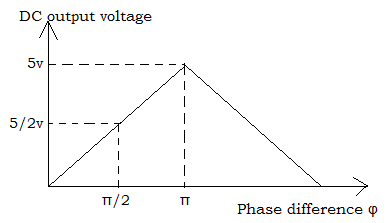1. Analog phase detector is often referred as
A. Full-wave detector
B. Half wave detector
C. Rectifier wave detector
D. None of the mentioned
2. What happens when VCO output is 90o out of phase with respect to the input signal?
A. Perfect lock
B. Attenuation
C. Shift in the phase of comparator
D. Error signal is removed
3. Find the error voltage of the phase comparator whose input signal is Vs= Vssin(2πfst) and the output signal Vo= Vosin(2πfot+φ).
A. Ve=[k×(Vs/2)]×[cos(-φ)-cos(2πfot+φ)].
B. Ve=[k×Vs×(Vo/2)]×[cos(-φ)-cos(2πfot+φ)].
C. Ve=[k×Vs×(Vo/2)]×[cos(-φ)+cos(2πfot+φ)].
D. Ve=[k×Vs×Vo]×[cos(-φ)-cos(2πfot+φ)].
4. How to overcome the problem associated with switch-type phase detective?
A. Increase loop gain depending on the input signal
B. Phase shift is made linear
C. Limit the amplifier of the input signal
D. All of the mentioned
5. If the average error voltage & the phase shift are given as 6.2v & π/4.Determine the phase angle to voltage transfer coefficient of the full-wave switching phase detector.
A. -0.19
B. -0.09
C. -0.03
D. -0.13
6. When does a digital phase detector can be used, where fo->output frequency, fs->input frequency.
A. Both fo & fs signals should be a square wave
B. fo should be square wave & fs can be any non-sinusoidal wave
C. fs should be a square wave & fo can be any non-sinusoidal wave
D. Both fo & fs can be any non-sinusoidal wave
7. The maximum dc output voltage in the digital phase detector occurs
A. When the phase difference is π/2
B. When the phase difference is π
C. When the phase difference is 3π/4
D. When the phase difference is 2π
8. Given the DC output voltage versus phase difference φ curve. Find the conversion gain values.

A. 15.7V/rad
B. 1.26V/rad
C. 1.59V/rad
D. 0.8V/rad
9. Which among the following has better capture tracking & locking characteristics?
A. XOR phase detector
B. Edge triggered phase detector
C. Analog phase detector
D. All of the mentioned
10. Which device is used for diagnostic purposes and for recording?
A. Low pass filter
B. Monolithic PLL
C. Voltage Controlled Oscillator
D. None of the mentioned
